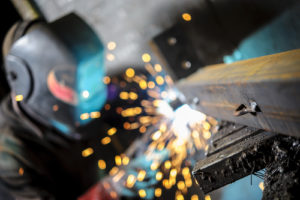A lot of people come to us with the question of which is better: cast iron or cast steel. The simplest answer is, neither; what works best boils down to the exact requirements you have. To start off, below is a look at what the two actually are.
Cast iron is a gray colored iron, which is known for its high ductility and malleability. It is basically an iron casting that is 2% carbon, or more. Cast steel, on the other hand is the normal carbon steel, or even alloy steel. This is essentially a steel casting which carries carbon content of under 2%. Both weigh more than aluminum die casting.
Cast Iron: Pros and Cons
There are many good casting properties, which you will find in gray cast iron: good vibration damping, superior machinability, better wear resistance, and minimal sensitivity. Despite this, the elongation and tensile strength of this material are very low, for which reason it can only be sued to produce metals that have low physical requirements. It can be included in the manufacture of protective cover, hand wheels, oil pan, floor, frame, small handle, hammer, frame, base, knife, box, bearing seat, bed, wheels, table, pump, cover, pipe, valve, motor blocks, and flywheel.
The higher grades of gray cast iron can take a significantly higher amount of load, as well as tightness. They are also more resistant to corrosion. This allows their use in the more vital casting, including gears, cylinder, flywheels, base, cylinder block, bed, piston, cylinder liner, brake wheel, gearbox, medium pressure valve, coupling plate, etc.
The ductile and malleable types of iron carry better strength and heat resistance, as well as toughness. In wider applications, these can even be used as replacement for carbon steel, although the production technology is more advanced, and the process more complex, which consequently raise the cost to much higher than what gray cast iron or cast steel come at. The other main problem is the higher incidence of casting defects. Ductile iron finds use in many fields, including pressure pipes and their fitting, agriculture, automotives, general engineering, and construction and road applications.
Cast Steel: Pros and Cons

Iron Die Casting
Cast steel is mainly preferred for its design flexibility. The casting designer enjoys wide freedom when picking among design choices. This is what allows for the creation of complex shapes, as well as hollow cross-section parts. Cast steel has high manufacturing flexibility, coupled with strong variability. It is possible to go with a different chemical composition in order to control the outcome intended for various projects. There are diverse heat treatment choices, which can be opted for, which have different effects on the performance and mechanical properties of the final product. Cast steel also carries better workability and weldability.
Cast steel is isotropic, which allows it to be made into steel castings that impart overall structural strength. This almost always improves the stability of the structure or project. That along with the weight, the short delivery time, and the economy of the option, makes it a good choice to go with. Steel castings tend to be heavier, weighing much more than an aluminum die casting of the same size. The larger castings can weigh up to many hundreds of tons.
It is possible to use steel castings in a wide range of working conditions, owing to their superior mechanical properties. They can stand up to severely high tensile stress and dynamic load, which makes them a logical inclusion in pressure vessel castings. If low or high temperatures are a given, it is best to have the large load bearing parts made of steel castings.
The downside to cast steel is that they have relatively bad suction, mobility, and wear resistance. The performance is also less satisfactory when you consider what cast iron can provide, but the costs are much higher. So when choosing between cast iron and cast steel, you would need to pay attention to the applications, as well as the physical properties you want in the casting.
Equipments used for Die Casting
Two main types of machines are used for die casting: hot-chamber and hot-chamber. Each machine’s rating is based on the maximum clamping force it can bring to bear, with typical ratings ranging from 400 tons to 4,000 tons.
Hot-chamber machines, also called gooseneck machines, require a steady supply of molten metal that is fed to the die. The originally retracted hydraulic-powered piston forces the metal out the gooseneck and into the die. These machines have fast cycle times. Cold-chamber machines are used for metals which cannot be cast using hot-chamber machines, such as aluminum, magnesium, and copper. So when casting aluminum, the separately melted metal is introduced into the unheated shot chamber, and then driven into the die using a mechanical or hydraulic-powered piston. These machines have slower cycle times.
